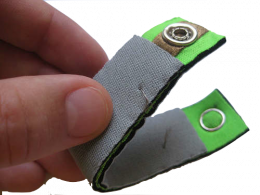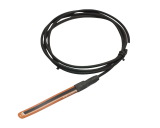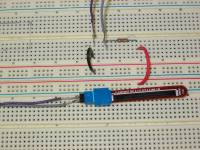Table of Contents
Flexion
Summary
Flexion sensors, (from Latin flectere, 'to bend') also called bend sensors, measure the amount of deflection caused by bending the sensor. There are various ways of sensing deflection, from strain-gauges1) to hall-effect sensors2). The three most common types of flexion sensors are:
- conductive ink-based
- fibre-optic
- conductive fabric/thread/polymer-based
A property of bend sensors worth noting is that bending the sensor at one point to a prescribed angle is not the most effective use of the sensor. As well, bending the sensor at one point to more than 90˚ may permanently damage the sensor. Instead, bend the sensor around a radius of curvature. The smaller the radius of curvature and the more the whole length of the sensor is involved in the deflection, the greater the resistance will be (which will be much greater than the resistance achieved if the sensor is fixed at one end and bent sharply to a high degree). In fact, Infusion Systems define the sensing parameter as “flex angle multiplied by radius”.
Specifications
A typical bend sensor has the following basic specifications:
- range of deflection
- uni- vs. bi-directional sensing
- uni- vs. bi-polar sensing
- range of resistance (nominal to full-deflection)
Range of deflection: Determines the maximum angle of deflection that can be measured (as opposed to the maximum angle the sensor can be bent).
Uni- vs. bi-directional sensing: Some flexion sensors increase the resistance when bent in either of two opposing directions, however there is no difference in the measurement with respect to the direction.
Uni- vs. bi-polar sensing: A bi-polar flexion sensor measures deflection in two opposing directions yielding different measurements.
Range of resistance: Bend sensors can vary largely (even the same product) in terms of their range of resistance, measured as the difference from nominal resistance to resistance at full deflection.
Conductive Ink-based
These types of bend sensors are passive resistive devices typically fabricated by laying a strip of resistive ink on a flexible plastic substrate, shaped as a thin, flexible stripe in lengths between 1“ and 5”. At rest (when laid flat), the bend sensor is characterized by an intrinsic resistance. As the sensor is bent, the resistive materials inside it are pulled further apart. Fewer adjacent resistive particles come into contact, thereby increasing the resistance. Typically, the nominal resistance lays between 10kΩ and 50kΩ and increases by a factor of 10 at full deflection. The resistance can be converted into a voltage as described here.
Within the layers of the flex sensor substrate is a printed pattern of conductive ink. To conduct electricity, this ink contains carbon, or silver, particles mixed into a pigmented medium. Typically, the carbon particles are suspended in the ink to avoid fading of the pigment over time. This type of ink can also be safely applied to paper to avoid absorption into the fibers, thus changing the paper’s properties. However, the carbon particles may be sensitive to changes in humidity that can lead to smudging of the ink (http://en.wikipedia.org/wiki/Ink).
Here is a link, typical of an ink producer for Conductive Compounds, explaining the properties of the ink and how it may be prepared for use in a custom design: http://www.nicomatic.co.uk/pages/products/conductive%20compounds/c100.htm
Most conductive ink-based bend sensors on the market are unipolar devices, that is the resistance increases as the deflection increases in one direction, and is unchanged if bent in the other direction. Placing two devices back-to-back will allow bipolar measurements for capturing deflections in both directions. Hysteresis and noise in resistance value are small if not entirely negligible.
Flexpoint Sensor Systems Inc. makes the Bend Sensor® in 1“, 2”, and 3“ lengths. They are available with connectors that can be interfaced with standard sized headers.

As length increases, the intrinsic resistance goes up, as does the resistance for each sensor at full deflection. As well, there are different lamination and coating options to increase durability and stiffness. For mechanical and electrical design guides, refer to these links: mechanical specs and electronic specs.
Images Scientific Instruments offers the bipolar flexion sensor FLX-02, which increases resistance in one direction and decreases resistance in the other direction. In addition, Images SI sells a special component-based flexion sensor which can also be used as a pressure sensor. This sensing principle is identical to conductive/thread/polymer-based sensing illustrated below. Worth mentioning is the online tutorial on how to construct a bi-directional (not: bi-polar!) bend sensor using a stripe of resistive material which is sandwiched between two copper clad laminates and sealed using heat shrink tubing.
Infusion Systems sells piezo-resistive bend sensors that work with greater ranges of deflection (larger flex angles), though at a higher cost. One example is the BendShort v2.0 sensing bi-polar deflection from -180 to +180 degrees. A promotional videoclip is available here
Properties
- hysteresis/noise neglectible3)
- resistance is function of radius of curvature, not angle at one point
- high temperature and humidity-tolerance
- relatively low cost
- customizable (coatings, laminating materials)
Applications
- industrial applications, e.g. safety switches, shipping, machine control
- medical applications (e.g. “SmartBed”)
- gaming devices
- measuring devices
- assistive technology
- robotics (e.g. floor mapping, collision detection)
Fiber-optic
Fiber-optic bend sensors (also called optical goniometers) consist of a light source, a plastic optical fibre (POF) with an abraded section and a photosensitive detector4). Light is emitted into the POF at one end and sensed at the other end. Bending the optical fibre results in a loss of light (intensity). The loss of light is often enhanced by cutting, polishing or abrasing a part of the POF5). Due to the sensing principle single fiber-optical bend sensors are uni-polar devices.
The image on the right shows a fiber-optic bend sensor with abraded section as used in TWEND.
A bend sensor can also be made from a length of fiber optic cable with an LED and a photodiode placed at both ends of a section of cable; Here is a link where fiber optic cable can be purchased and the data sheet is available (http://i-fiberoptics.com/fiber-detail.php?id=106).
Measurand Inc. offers several products employing fiber-optic bend-sensing. The Shapetape, for example, generates spatial information entirely from bend and twist information using an array of pairs of fiber optic sensors in a rubber coating. Each sensor pair integrates curvature and reports the net angular difference (NAD). NAD is used to calculate the cartesian coordinates (x,y,z) of the end of the pair relative to its start. Accordingly, the spatial sensor density determines the smallest features that may be measured accurately.
La Kitchen used to sell a fiber optical flex sensor which can be bent in any direction and senses global deflection. Unfortunately, La Kitchen has closed its doors.
Properties
- mostly custom-built or developed in the lab
- high repeatability, hysteresis neglectible
- can be bent in any direction
- usually unipolar measurement (global flexion)
- can be expensive
Applications
- medical applications
- educational studies (e.g. the CARESS project)
Conductive Fabric/Thread/Polymer-based
 Conductive fabric-, thread- or polymer-based flexion sensors typically consist of two layers of conductive material with a layer of resistive material (e.g. Velostat) in between. It is mostly sandwiched inbetween layers of more rugged material, e.g. Neoprene. As pressure is applied (directly or by bending) the two layers of conductive material get pushed closer together and the resistance of the sensor decreases. This sensing mechanism is similar to force-sensitive resistors. Strictly speaking, these types of sensors are pressure sensors which also sense deflection (pressure as a function of deflection): bending the sensor across an angle of a rigid structure results in stretch of the sensor material which exerts pressure onto the sensor. It is this pressure that is measured. Foam/Polymer-based sensors decrease their nominal resistance as the material is compressed. These sensors are known to have poor accuracy, repeatability and hysteresis6). External links to distributers and manufacturers of conductive fabric/thread can be found at the bottom of this page. An interesting paper on the use of conductive fabric for sensing purposes can be found here.
Conductive fabric-, thread- or polymer-based flexion sensors typically consist of two layers of conductive material with a layer of resistive material (e.g. Velostat) in between. It is mostly sandwiched inbetween layers of more rugged material, e.g. Neoprene. As pressure is applied (directly or by bending) the two layers of conductive material get pushed closer together and the resistance of the sensor decreases. This sensing mechanism is similar to force-sensitive resistors. Strictly speaking, these types of sensors are pressure sensors which also sense deflection (pressure as a function of deflection): bending the sensor across an angle of a rigid structure results in stretch of the sensor material which exerts pressure onto the sensor. It is this pressure that is measured. Foam/Polymer-based sensors decrease their nominal resistance as the material is compressed. These sensors are known to have poor accuracy, repeatability and hysteresis6). External links to distributers and manufacturers of conductive fabric/thread can be found at the bottom of this page. An interesting paper on the use of conductive fabric for sensing purposes can be found here.
Properties
- quasi-linear behaviour for pressure-sensing
- slow response, due to physical deformation (internal energy)
- high hysteresis, poor accuracy & repeatability
- high temperature- and humdidity-tolerance (can be used underwater)
- highly customizable
- cheap
Applications
Comparison
The characteristic features of the above types of sensors can be summarized in compliance with 6) as follows:
| conductive ink | fibre-optic | fabric/polymer |
|---|---|---|
| + robust & durable | + accurate, repeatable measurements | + attractive physical qualities |
| - fixed lengths, drift | - requires light-source & detector | - poor & variable performance |
Devices
| Flexpoint Bend Sensor® | |
|---|---|
| Sources | Flexpoint US$12.95 |
| Description | uni-directional Bend Sensor |
| Datasheet | |
| Resources | Electrical Guide, Mechanical Guide |
| Notes | resistance: ≈10kΩ (0°); ≈250KΩ (90°) |
| Variants | Available varying lengths and coatings, with or without connectors |
| Images Scientific Instruments FLX-02 | |
|---|---|
| Sources | Images SI US$ 14.95 |
| Description | Bi-polar Flex Sensor |
| Datasheet | |
| Resources | |
| Notes | dimensions: 0.25“w, 4.5”l, 0.019“t temperature: -45f to 125F resistance: 25kΩ (nominal), may vary from 10kΩ to 40kΩ |
| Variants | |
FLX-03L/M (low/medium resistance: 12kΩ +-20%, 15kΩ +-20%) |
| Images Scientific Instruments FLX-01 | |
|---|---|
| Sources | Images SI US$ 9.95 |
| Description | Bi-directional Bend & Pressure Sensor |
| Datasheet | |
| Resources | |
| Notes | uses special component that changes resistance when bent or compressed. dimensions: 0.375“w, 4.5”l, 0.038“t temperature: -45f to 125F resistance: 10kΩ (nominal) |
| Variants | FLX-01L/M/H (low/medium/high resistance, 1kΩ-200kΩ) |
| Spectra Symbol FLX-01 | |
|---|---|
| Sources | Sparkfun US$ 12.95 |
| Description | uni-directional flex sensor SEN-08606 |
| Datasheet | Promotional PDF |
| Resources | |
| Notes | This sensor has been used in gaming devices, such as the Nintendo Power Glove and Essential Reality's p5Glove. resistance: 9kΩ (nominal), 14kΩ (90º), 20 kΩ (180º) |
| Variants | |
| Infusion Systems BendShort | |
|---|---|
| Sources | Infusion Systems US$ 61.83 |
| Description | Bi-polar Flex Sensor |
| Datasheet | online version |
| Resources | |
| Notes | |
dimensions: 3.3 x 0.24 x 0.004 inch |
Media
External Links
- For more information on flex sensors go here
- Images SI's tutorial on how to make a bi-directional flex sensor can be found here
- Promotional video showing Infusion System's “BendShort v2.0” in action
- A tutorial on how to build a fabric bend sensor can be found here




